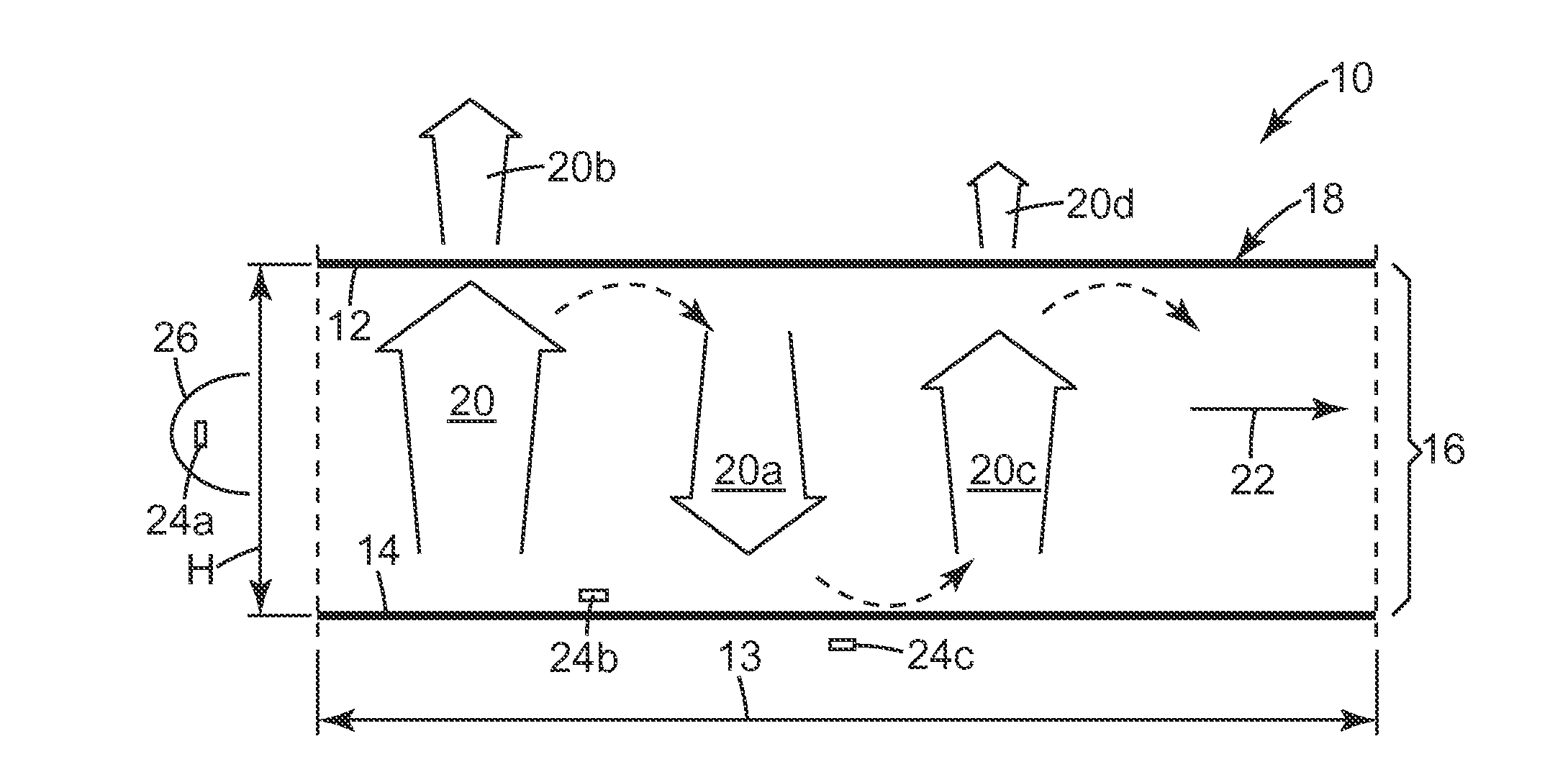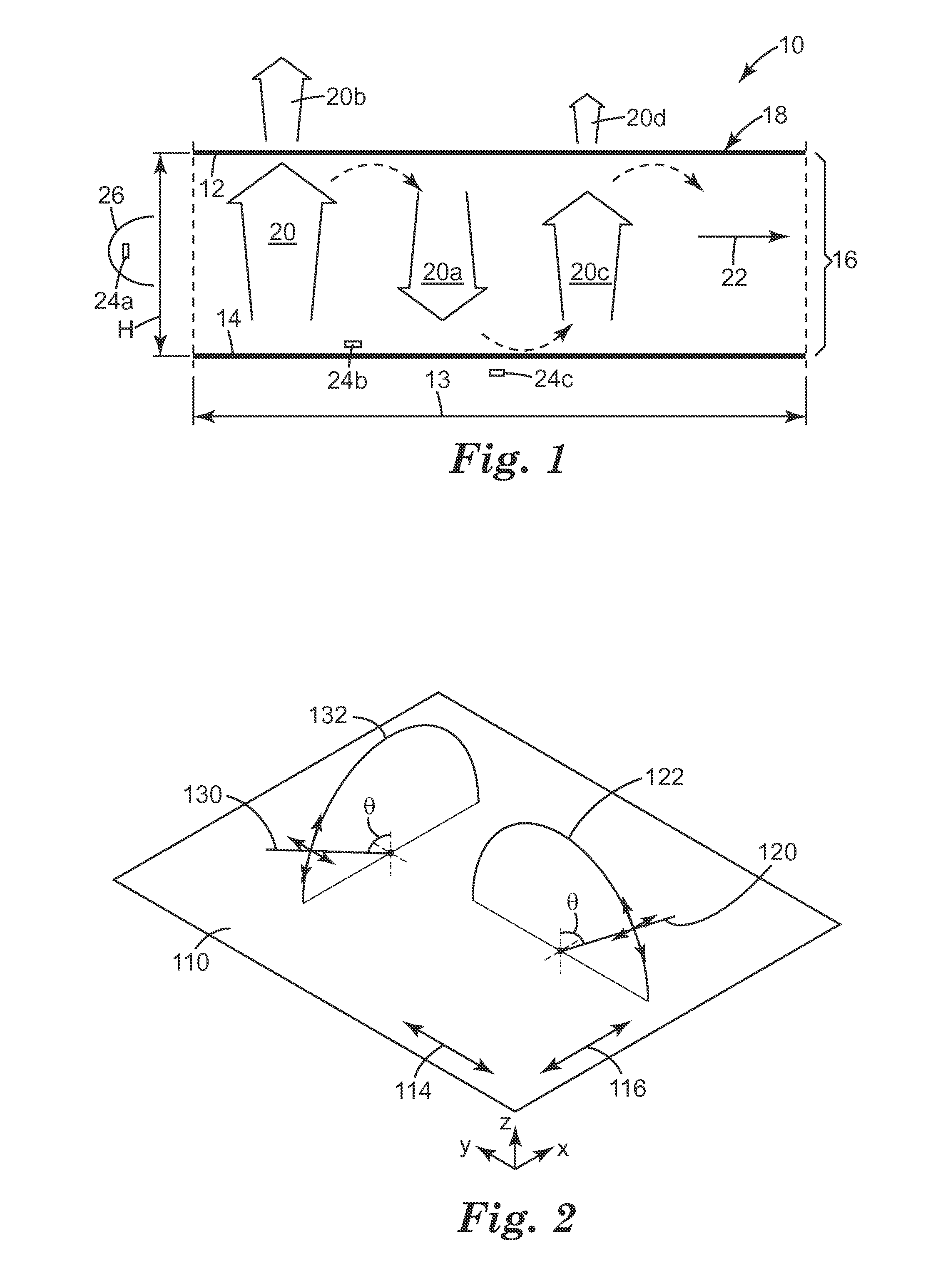Illumination systems with sloped transmission spectrum front reflector
a transmission spectrum front reflector and illumination system technology, applied in the field of extended area illumination systems, can solve problems such as inefficiency, achieve the effects of small collective source area ratio, low hemispherical reflectivity, and low loss of light sources
- Summary
- Abstract
- Description
- Claims
- Application Information
AI Technical Summary
Benefits of technology
Problems solved by technology
Method used
Image
Examples
example 1
Gold-822a as Front Reflector on an Edge-Lit, Ink-Dot Extractor Light Guide Backlight
[0111]This apodized broadband partial reflector (ABPR) with differing optical packets (see Attorney Docket No 67820US002) of Example 1, was manufactured using the feedblock method described in U.S. Patent Application 61 / 332,401 (Attorney Docket No. 64248US002) entitled “Feedblock for Manufacturing Multilayer Polymeric Films”, filed May 7, 2010. Two packets of 275 layers each of alternating low and high index polymer layers were coextruded as a cast web and then stretched in a tenter on a continuous film making line. The high index material was a 90 / 10 coPEN (90% naphthalate units and 10% teraphthalate units). The low index material was differed between packet 1 and for packet 2 of the microlayers. The low index material for packet 1 was a blend of PETg (EASTAR GN071 copolyester from Eastman Chemical, Kingsport, Tenn.) and an amorphous 55 / 45 coPEN (55% naphthalate units and 45% terephthalate units). T...
example 2
Gold-822C as Front Reflector on an Edge-Lit, Ink-Dot Extractor Light Guide Backlight
[0123]The apodized broadband partial reflectors (ABPR) with differing optical packets (as described in Attorney Docket No. 67820US002) of Example 2, was manufactured using the feedblock method described in U.S. Patent Application 61 / 332,401 (see Attorney Docket No. 64248US002) entitled “Feedblock for Manufacturing Multilayer Polymeric Films”, filed May 7, 2010. Two packets of 275 layers each of alternating low and high index polymer layers were coextruded as a cast web and then stretched in a tenter on a continuous film-making line. The high index material was a 90 / 10 coPEN (90% naphthalate units and 10% teraphthalate units). The low index material was differed between packet 1 and for packet 2 of the microlayers. The low index material for packet 1 was PETg (EASTAR GN071 copolyester, Eastman Chemical, Kingsport, Tenn.) with an index of 1.565. The low index material for packet 2 was a co-polyester ha...
example 3
Gold-822F as Front Reflector on an Edge-Lit, Ink-Dot Extractor Light Guide Backlight
[0134]The apodized broadband partial reflector (ABPR) with differing optical packets (See Attorney Docket No 67820US002) of Example 3, was manufactured using the feedblock method described in U.S. Patent Application 61 / 332,401 (Attorney Docket No. 64248US002) entitled “Feedblock for Manufacturing Multilayer Polymeric Films,” filed May 7, 2010. Two packets of 275 layers each of alternating low and high index polymer layers were coextruded as a cast web and then stretched in a tenter on a continuous film making line. The high index material was a 90 / 10 coPEN (90% naphthalate units and 10% teraphthalate units). The low index material was differed between packet 1 and packet 2 of the microlayers. The low index material for packet 1 was a blend of PETg (EASTAR GN071 copolyester from Eastman Chemical, Kingsport, Tenn.) and an amorphous 55 / 45 coPEN (55% naphthalate units and 45% terephthalate units). The bl...
PUM
| Property | Measurement | Unit |
|---|---|---|
| hemispherical reflectivity | aaaaa | aaaaa |
| hemispherical reflectivity | aaaaa | aaaaa |
| hemispherical reflectivity | aaaaa | aaaaa |
Abstract
Description
Claims
Application Information
 Login to View More
Login to View More - R&D
- Intellectual Property
- Life Sciences
- Materials
- Tech Scout
- Unparalleled Data Quality
- Higher Quality Content
- 60% Fewer Hallucinations
Browse by: Latest US Patents, China's latest patents, Technical Efficacy Thesaurus, Application Domain, Technology Topic, Popular Technical Reports.
© 2025 PatSnap. All rights reserved.Legal|Privacy policy|Modern Slavery Act Transparency Statement|Sitemap|About US| Contact US: help@patsnap.com



